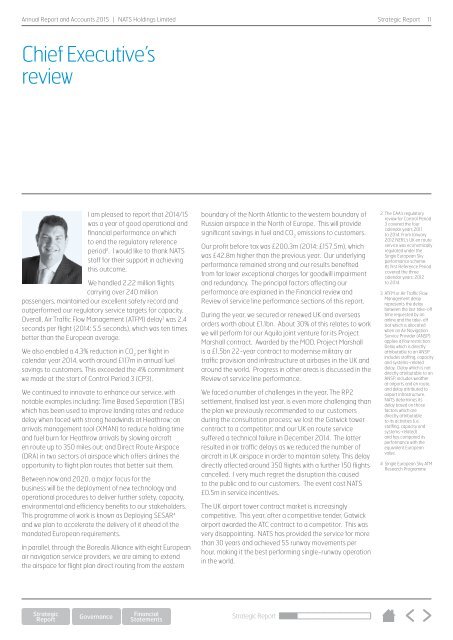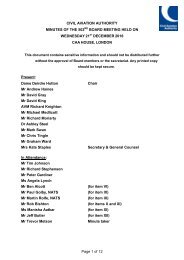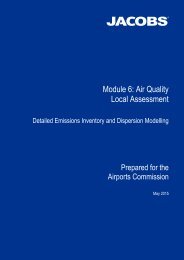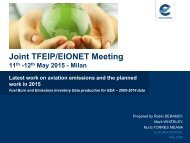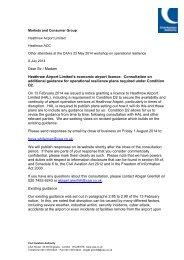NATS-Annual-Report-2015
NATS-Annual-Report-2015
NATS-Annual-Report-2015
You also want an ePaper? Increase the reach of your titles
YUMPU automatically turns print PDFs into web optimized ePapers that Google loves.
<strong>Annual</strong> <strong>Report</strong> and Accounts <strong>2015</strong> | <strong>NATS</strong> Holdings Limited<br />
Strategic <strong>Report</strong><br />
11<br />
Chief Executive’s<br />
review<br />
I am pleased to report that 2014/15<br />
was a year of good operational and<br />
financial performance on which<br />
to end the regulatory reference<br />
period 2 . I would like to thank <strong>NATS</strong><br />
staff for their support in achieving<br />
this outcome.<br />
We handled 2.22 million flights<br />
carrying over 240 million<br />
passengers, maintained our excellent safety record and<br />
outperformed our regulatory service targets for capacity.<br />
Overall, Air Traffic Flow Management (ATFM) delay 3 was 2.4<br />
seconds per flight (2014: 5.5 seconds), which was ten times<br />
better than the European average.<br />
We also enabled a 4.3% reduction in CO 2<br />
per flight in<br />
calendar year 2014, worth around £117m in annual fuel<br />
savings to customers. This exceeded the 4% commitment<br />
we made at the start of Control Period 3 (CP3).<br />
We continued to innovate to enhance our service, with<br />
notable examples including: Time Based Separation (TBS)<br />
which has been used to improve landing rates and reduce<br />
delay when faced with strong headwinds at Heathrow; an<br />
arrivals management tool (XMAN) to reduce holding time<br />
and fuel burn for Heathrow arrivals by slowing aircraft<br />
en route up to 350 miles out; and Direct Route Airspace<br />
(DRA) in two sectors of airspace which offers airlines the<br />
opportunity to flight plan routes that better suit them.<br />
Between now and 2020, a major focus for the<br />
business will be the deployment of new technology and<br />
operational procedures to deliver further safety, capacity,<br />
environmental and efficiency benefits to our stakeholders.<br />
This programme of work is known as Deploying SESAR 4<br />
and we plan to accelerate the delivery of it ahead of the<br />
mandated European requirements.<br />
In parallel, through the Borealis Alliance with eight European<br />
air navigation service providers, we are aiming to extend<br />
the airspace for flight plan direct routing from the eastern<br />
boundary of the North Atlantic to the western boundary of<br />
Russian airspace in the North of Europe. This will provide<br />
significant savings in fuel and CO 2<br />
emissions to customers.<br />
Our profit before tax was £200.3m (2014: £157.5m), which<br />
was £42.8m higher than the previous year. Our underlying<br />
performance remained strong and our results benefited<br />
from far lower exceptional charges for goodwill impairment<br />
and redundancy. The principal factors affecting our<br />
performance are explained in the Financial review and<br />
Review of service line performance sections of this report.<br />
During the year, we secured or renewed UK and overseas<br />
orders worth about £1.1bn. About 30% of this relates to work<br />
we will perform for our Aquila joint venture for its Project<br />
Marshall contract. Awarded by the MOD, Project Marshall<br />
is a £1.5bn 22-year contract to modernise military air<br />
traffic provision and infrastructure at airbases in the UK and<br />
around the world. Progress in other areas is discussed in the<br />
Review of service line performance.<br />
We faced a number of challenges in the year. The RP2<br />
settlement, finalised last year, is even more challenging than<br />
the plan we previously recommended to our customers<br />
during the consultation process; we lost the Gatwick tower<br />
contract to a competitor; and our UK en route service<br />
suffered a technical failure in December 2014. The latter<br />
resulted in air traffic delays as we reduced the number of<br />
aircraft in UK airspace in order to maintain safety. This delay<br />
directly affected around 350 flights with a further 150 flights<br />
cancelled. I very much regret the disruption this caused<br />
to the public and to our customers. The event cost <strong>NATS</strong><br />
£0.5m in service incentives.<br />
The UK airport tower contract market is increasingly<br />
competitive. This year, after a competitive tender, Gatwick<br />
airport awarded the ATC contract to a competitor. This was<br />
very disappointing. <strong>NATS</strong> has provided the service for more<br />
than 30 years and achieved 55 runway movements per<br />
hour, making it the best performing single-runway operation<br />
in the world.<br />
2 The CAA’s regulatory<br />
review for Control Period<br />
3 covered the four<br />
calendar years 2011<br />
to 2014. From January<br />
2012 NERL’s UK en route<br />
service was economically<br />
regulated under the<br />
Single European Sky<br />
performance scheme.<br />
Its first Reference Period<br />
covered the three<br />
calendar years: 2012<br />
to 2014.<br />
3 ATFM or Air Traffic Flow<br />
Management delay<br />
represents the delay<br />
between the last take-off<br />
time requested by an<br />
airline and the take-off<br />
slot which is allocated<br />
when an Air Navigation<br />
Service Provider (ANSP)<br />
applies a flow restriction.<br />
Delay which is directly<br />
attributable to an ANSP<br />
includes staffing, capacity<br />
and systems-related<br />
delay. Delay which is not<br />
directly attributable to an<br />
ANSP, includes weather<br />
at airports and en route,<br />
and delay attributed to<br />
airport infrastructure.<br />
<strong>NATS</strong> determines its<br />
delay based on those<br />
factors which are<br />
directly attributable<br />
to its activities (i.e.<br />
staffing, capacity and<br />
systems-related)<br />
and has compared its<br />
performance with the<br />
equivalent European<br />
value.<br />
4 Single European Sky ATM<br />
Research Programme<br />
Strategic <strong>Report</strong>


